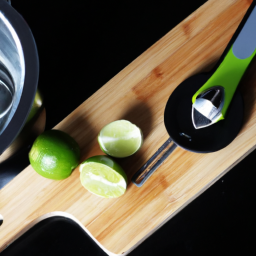For centuries, cactus juice has been used as a natural remedy for various health concerns such as digestive problems, inflammation, and fatigue. It is more than just a healthy drink, as it also provides a unique flavor combination of sweetness and tanginess.
In this article, I will guide you through the process of making cactus juice from scratch, so you can enjoy this refreshing beverage at home.
Before we get started, let’s gather the materials. You will need a fresh cactus, a sharp knife, a blender, a cheesecloth, and a container to store the juice. It’s important to note that not all cacti are edible, so make sure to choose a variety that’s safe for consumption. Additionally, cacti have spines that can cause injury, so be careful when handling them.
With that said, let’s dive into the process of making cactus juice.
Key Takeaways
- Cactus juice is a traditional remedy that is known for its numerous health benefits, including aiding in digestion, regulating blood sugar levels, and boosting the immune system.
- Making cactus juice requires proper preparation of the cactus, including removing the spines and skin, blending the cactus pads with water, and adding natural sweeteners or flavor variations.
- Cactus juice can be customized with various flavors and can be used in various recipes, such as cocktails, mocktails, and marinades.
- Proper storage and preservation techniques are crucial to reduce spoilage and preserve the nutritional benefits of the cactus juice.
Gathering the Materials
You’ll need to grab a pair of gloves and carefully pluck the prickly pear cactus fruit off the spiky plant, making sure to avoid any thorns. It’s important to find cactus that is ripe and ready to be harvested, which can be determined by its color and texture. The fruit should be a bright, vibrant color and soft to the touch.
When harvesting the cactus, it’s important to use proper techniques to ensure that the plant remains healthy and can continue to produce fruit in the future. One such technique is to only harvest a portion of the fruit from each plant, leaving some behind for the plant to use for energy and growth. Additionally, it’s important to avoid damaging the cactus pads or stem while harvesting.
The prickly pear cactus fruit is not only delicious, but it also has numerous health benefits and nutritional value. It is high in fiber, vitamin C, and antioxidants, and has been known to aid in digestion and lower cholesterol levels.
Now that we’ve gathered our prickly pear cactus fruit, it’s time to move on to preparing it for juicing.
Preparing the Cactus
I’ll now discuss the process of preparing the cactus for making juice.
The first step is to remove the spines and skin from the fruit. This can be done with a knife or vegetable peeler, taking care not to cut too deeply and lose too much of the flesh.
Next, the fruit should be thoroughly cleaned and cut into small pieces for blending.
Proper preparation of the cactus is crucial for achieving a smooth and tasty juice.
Removing the Spines and Skin
First, carefully hold the cactus with tongs and use a sharp knife to slice off the spines and skin, which can make up to 70% of the cactus’s weight. It’s important to remove all of the spines and skin as they’re not only inedible but can also cause irritation to the skin and mouth.
Removing spines and skin will also make it easier to blend the cactus and extract its juice. Aside from making cactus juice preparation easier, removing spines and skin also has health benefits. The skin of the cactus contains antioxidants and anti-inflammatory properties that can help boost the immune system and reduce inflammation in the body.
With all the spines and skin safely removed, the next step is to clean and cut the fruit.
Cleaning and Cutting the Fruit
To prepare the cactus fruit for consumption, start by gently scrubbing it under running water to remove any remaining debris or dirt. Once the fruit is clean, use a sharp knife to cut off the top and bottom ends. Then, make a lengthwise incision down the side of the fruit to open it up.
Inside, you’ll find a vibrant, juicy flesh that can range in color from pale green to deep red. Not only is cactus fruit delicious, but it’s also packed with health benefits and nutritional value. It’s a great source of vitamin C, fiber, and antioxidants which can help boost your immune system and protect against chronic diseases.
Now that the fruit is clean and cut, it’s time to move on to the next step of extracting the juice.
Extracting the Juice
Now, you’ll need to cut the cactus pads into small pieces and blend them with water until you have a smooth mixture that is roughly 50% water and 50% cactus.
Juice extraction techniques are crucial in ensuring that you get the maximum amount of juice from the cactus pads. The best way to extract the juice is by blending the cactus pads with water, as this helps to break down the tough fibers of the cactus. You can also use a juicer or a cheesecloth to extract the juice, but blending is the easiest and most effective method.
Aside from its unique taste, cactus juice is also known for its health benefits. The prickly pear cactus, commonly used to make cactus juice, is packed with essential vitamins and minerals that can help improve your overall health.
Cactus juice is also known to help lower cholesterol levels and improve digestion. With the juice extracted, it’s time to move on to the next step of flavoring the juice.
Flavoring the Juice
To add some flavor to your freshly extracted cactus juice, you can consider using natural sweeteners like honey or agave nectar. These sweeteners not only enhance the taste of the juice, but also provide additional health benefits. Honey, for instance, contains antioxidants and has antibacterial properties, while agave nectar has a low glycemic index and is suitable for people with diabetes.
Aside from sweeteners, you can also experiment with different flavors to make your cactus juice more interesting. Add a few drops of lime or lemon juice for a tangy twist, or mix in some fresh herbs like mint or basil for a refreshing taste. Whatever flavor you choose, be mindful of the amount you add, as too much can overpower the natural taste of the cactus juice.
When it comes to bottling and storing the juice, it’s important to keep it refrigerated and consume it within a few days to ensure its freshness.
Bottling and Storing the Juice
When it comes to bottling and storing cactus juice, there are a few key things to keep in mind.
First of all, it’s important to choose the right containers. Glass bottles with airtight lids are a great choice, as they’ll keep the juice fresh for longer.
Secondly, proper storage is crucial. Cactus juice should be kept in the refrigerator at all times to prevent spoilage.
Finally, preservation is also important. Adding a small amount of citric acid to the juice can help extend its shelf life even further.
Choosing the Right Containers
First things first, before I start making cactus juice, I need to make sure I have the right containers for storing it. Choosing the right containers is crucial to ensure that the juice doesn’t get spoiled or contaminated.
There are different size options available in the market, ranging from small jars to large bottles. I prefer using glass bottles as they’re reusable, easy to clean, and don’t contain harmful chemicals that can leach into the juice. Plus, glass bottles are perfect for keeping the juice fresh and preserving its flavor for a longer time.
If you’re looking for eco-friendly alternatives, you can opt for stainless steel or ceramic containers. These materials are durable, non-toxic, and don’t affect the taste or quality of the juice. However, make sure to avoid plastic containers as they can release harmful chemicals into the juice and affect its taste.
Once you have the right containers, it’s time to move on to the next step – proper storage and preservation of the cactus juice.
Proper Storage and Preservation
Now that we’ve invested in the perfect containers, let’s ensure we keep our delicious cactus juice fresh and flavorful for as long as possible.
Long term storage is key to reducing spoilage and preserving the nutritional benefits of the cactus juice. To achieve this, it’s important to store the juice in a cool and dark place, away from direct sunlight and heat sources. This will prevent the growth of bacteria and the oxidation of the juice, which can lead to spoilage.
In addition to proper storage, it’s also important to preserve the freshness of the cactus juice by keeping it refrigerated. This will help to slow down the breakdown of the juice’s natural enzymes and nutrients, which can affect the quality and taste of the juice.
By following these storage and preservation techniques, we can ensure that our cactus juice remains fresh and delicious for weeks to come.
Now, let’s move on to some serving suggestions that’ll help us enjoy our cactus juice to the fullest.
Serving Suggestions
When it comes to serving cactus juice, there are a few key points to keep in mind. First and foremost, it’s best to serve the juice chilled, as this helps to bring out its natural sweetness and refreshing qualities.
Additionally, cactus juice can make a delicious base for cocktails, and there are a variety of creative recipes out there to try. As someone who’s enjoyed experimenting with cactus juice, I can attest to the fact that it’s a versatile and delicious ingredient that can add a unique twist to any beverage menu.
Chilled Cactus Juice
To achieve a refreshing and soothing taste, nothing beats a glass of icy cold cactus juice on a hot summer day. Chilled cactus juice not only quenches your thirst but also provides numerous health benefits. It’s a rich source of antioxidants, vitamins, and minerals that boost your immune system, improve digestion, and regulate blood sugar levels. Moreover, cactus juice is low in calories and high in fiber, making it an ideal drink for weight watchers and fitness enthusiasts.
Apart from its health benefits, chilled cactus juice can be customized with various flavor variations. You can add a dash of lemon juice for a tangy twist or blend it with watermelon for a sweet and juicy flavor. You can also experiment with different herbs and spices like mint, ginger, or cinnamon to enhance the taste and aroma of your cactus juice.
So, grab a glass of chilled cactus juice, sit back, and enjoy the cool breeze of summer.
Moving on to cactus juice cocktails, let me share some exciting recipes that’ll take your cactus juice game to the next level.
Cactus Juice Cocktails
Indulging in a glass of cactus juice cocktail can elevate your summer drinking experience to a new level of sophistication. Cactus juice mocktails are a refreshing and unique alternative to traditional beverages. Mixing cactus juice with other ingredients such as pineapple, lime, and honey can create a sweet and tangy flavor profile that is sure to impress your guests at your next summer gathering.
Pairing cactus juice with food can be a fun and creative way to elevate your meals. The sweet and slightly tart flavor of cactus juice pairs well with spicy foods, such as Mexican cuisine or even barbecue. It can also be a great addition to a fruit salad or as a marinade for grilled meats. With its versatile flavor profile, cactus juice is a great ingredient to experiment with in the kitchen.
Moving on to the next section, let’s explore some alternative cactus juice recipes that you can try at home.
Alternative Cactus Juice Recipes
Believe it or not, there are actually some pretty wild alternative cactus juice recipes out there for the adventurous. If you’re looking to switch up your cactus juice game, here are a few flavor variations to consider:
- Spicy: Add a hint of jalapeño or habanero pepper for a kick.
- Sweet: Mix in some honey or agave syrup for a sweeter taste.
- Tangy: Add some lime or lemon juice for a citrusy twist.
- Herbal: Infuse the juice with some mint or basil leaves for a refreshing taste.
- Creamy: Mix in some coconut milk or almond milk for a creamy texture.
Not only are these alternative recipes fun to experiment with, but they also come with a variety of health benefits. Cactus juice is known for its anti-inflammatory and antioxidant properties, which can aid in digestion, boost the immune system, and even lower cholesterol levels.
So, why not try something new and reap the benefits while you’re at it?
When it comes to making cactus juice, there are a few tips and tricks to keep in mind.
Tips and Tricks
Get the most out of your prickly pear concoction with these helpful tips and tricks that’ll leave your taste buds begging for more.
Mixing flavors is a great way to add complexity to your cactus juice recipe. Try combining prickly pear with other fruits like mango or pineapple for a tropical twist. Or pair it with citrus fruits like lime or grapefruit for a tangy kick. You can also experiment with adding herbs like mint or basil for a refreshing twist.
Another way to enhance your cactus juice recipe is by experimenting with additives. Try adding a splash of coconut water for extra hydration. Or a pinch of salt to bring out the natural sweetness of the prickly pear. You can also try adding a bit of honey or agave syrup for a touch of sweetness. Or a dash of cayenne pepper for a spicy kick.
Don’t be afraid to get creative and find your own unique flavor combinations to make your cactus juice recipe truly one-of-a-kind.
Frequently Asked Questions
What are the health benefits of drinking cactus juice?
Drinking cactus juice has various benefits. It’s rich in antioxidants, vitamins, and minerals that boost immunity, regulate blood sugar, and aid digestion. Try recipes like prickly pear or nopal juice.
Can all types of cacti be used to make juice?
Not all cacti can be used to make juice. The sourcing of cacti for juice production is crucial to ensure safety and nutritional content. It is recommended to use edible cacti such as prickly pear or dragon fruit.
How long does it take for a cactus to grow to a size suitable for juice extraction?
Did you know that a cactus can take up to 15 years to reach a size suitable for juice extraction? Cactus farming techniques, such as proper watering and soil conditions, can speed up the cactus growth timeline.
Are there any safety precautions to take when handling cactus spines during preparation?
When handling cactus spines, I take caution by wearing thick gloves and using tongs. If a spine punctures the skin, I clean the wound with soap and water, and apply first aid. Removing spines with tweezers is recommended.
Can cactus juice be used as a substitute for other liquids in recipes, such as in smoothies or cocktails?
Cactus juice can be used in baking and as a natural remedy for stomach ailments. It can also serve as a substitute for other liquids in recipes such as smoothies or cocktails.
Conclusion
In conclusion, making cactus juice is a unique and rewarding experience that requires patience, precision, and a little bit of experimentation. It’s much like tending to a garden, where the effort and care put into the process will yield a delicious and refreshing drink.
As with any endeavor, there may be setbacks and challenges along the way, but with perseverance and determination, the end result will be worth it. Just like how each cactus plant is different, every batch of cactus juice will have its own unique flavor and characteristics.
It’s important to embrace these differences and appreciate the individuality of each batch. So, go ahead and give it a try – who knows, you may just discover your new favorite drink!
Ilana has been a vegan for over 10 years. She originally made the switch for health reasons, but soon found herself becoming more and more passionate about the ethical and environmental implications of a vegan lifestyle. Ilana is the author of The Graceful Kitchen, a blog all about veganism. She loves to cook up delicious and nutritious vegan meals, and share her recipes with others who are interested in leading a cruelty-free life. Ilana is also a strong advocate for using whole foods as the foundation of a healthy diet, and believes that going vegan is one of the best ways to achieve this.










